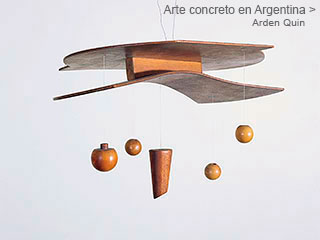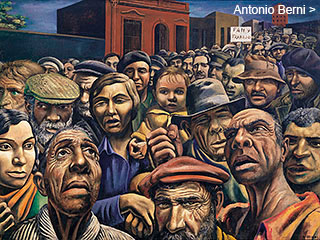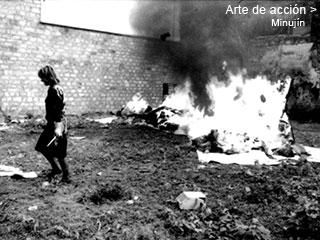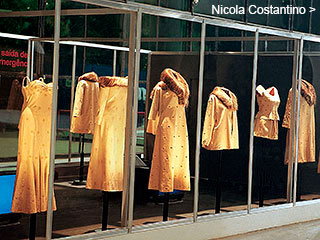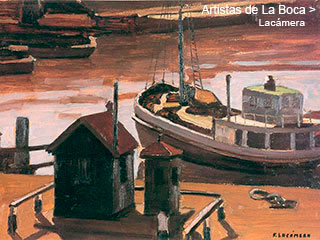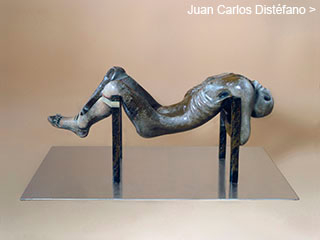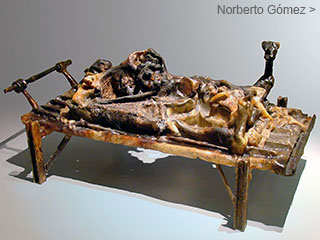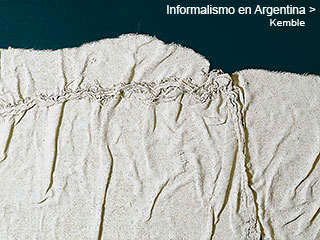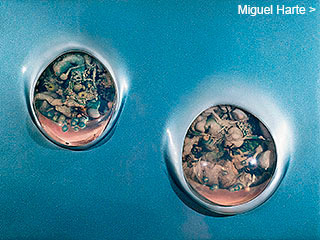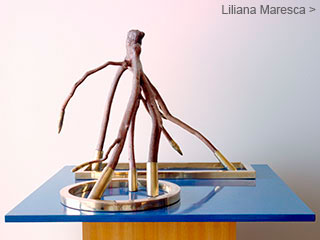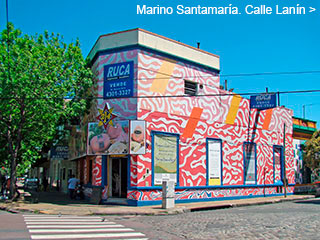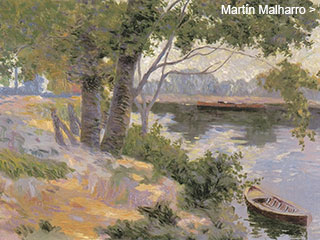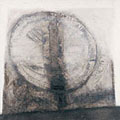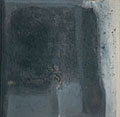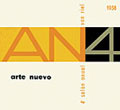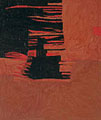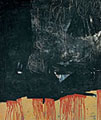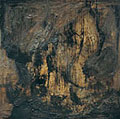Menú
Algunos dossiers
Informalism
in Argentina
in Argentina
by
Jorge López Anaya
August 2003
August 2003
Argentine Informalism incorporated processes which went against the “good taste” of the local practices. Based on the existential poetry of the time, through spontaneous gestures and the use of discarded material, it violated the limits of the traditional artistic genre and opened the road to the concept of the object, the installations and the art of action.
Seven Abstract Painters
In October 1957, a group of artists gathered under the name of Seven Abstract Painters, held their first exhibition at the Pizarro Gallery. It was made up of Osvaldo Borda, Víctor Chab, Josefina Miguens, (who later signed as Josefina Robirosa), Rómulo Macció, Martha Peluffo, Kazuya Sakai and Clorindo Testa. They all evidenced an inclination towards a “warm” abstraction, as a subtle and general form of opposition to the “cold” or geometric abstraction of the time, and as a valorization of the spontaneous expression and of the immediate but controlled tracing. The work of these seven painters could be grouped according to the use of the symbolic elements, their free tracings, the colorful surfaces, the textures and even of a certain sensitive geometry.
The collective activity of the Seven Abstract Painters went on throughout 1958, when it connected with Boa magazine founder and director, the poet and critique Julio Llinás who published their work under the name of “International notebooks of Documentation about Poetry and Vanguard Art”. The magazine served as a catalogue for the second exhibition of the group.
What is the "whatchamacallit"
Also in 1957, but towards a different direction, a small group of young artists tried to break away from the imperative formalism in Buenos Aires. They did this by following the foot steps of art brut, dadá, Duchamp, almost without information about the most recent artistic trends. In 1956, Jorge López Anaya, Jorge Martin and Mario Valencia (today known as the San Isidro Group), whose ages ranged between twenty and twenty five, started painting canvases which opposed the basis of the current trends. During that year and the following one, they made a series of pieces that rebelled against all of the conventionalisms and the lessons of “proper painting”. This opposition, which led them to baptize their work as “whatchamacallits”, clearly marked the distance that they wanted to take from the more or less conventional geometrical abstraction or lyrical forms of the time.
Informalist Movement
On April 21, 1958, the IV Salon of the Asociación Arte Nuevo (New Art Association) was inaugurated at the Pizarro Gallery. Among the abstractions presented (geometric or free form) a particular piece stood out as it was based on the use of poor and heteroclite materials, discarded objects and dirty, stained rags. Kenneth Kemble was the author of this outrageous collage that rudely challenged the dominant esthetics of the time, radically opposing to the smoothness, the precision and the refinement of the predominant abstract forms of the time.
Kemble presented two collages. The vulgarity of the materials, their ugliness and degradation produced evident distaste among the organizers of the exhibition, even though when one of the characteristics of the event at the Association was the absence of judgment of the pieces previous to the exhibit. The directors of New Art Association communicated to the unknown artist, that even though they respected his creative freedom, they thought it convenient to modify his entry because his collages did not mix in well with the rest of the pieces. Upon Kemble’s refusal to adapt his work accordingly, they chose to only show one of his pieces. They picked one dated 1957, made of dirty, worn out rags.
That same year, a good part of the artists that adhered to Informalism participated in individual or collective exhibitions: in September Towas presented his work at the Galatea Gallery; in October Alberto Greco exhibited with various San Pablo artists at the Antígona Gallery; Fernando Maza took part in an exhibition at the Rubbers Gallery; Pucciarelli exhibited at the Galatea Gallery in September. Luis Alberto Wells presented monoprints at this same gallery during the month of October. Within this context, the adhesion to the Informalist direction was fast and without any major transitions. The first exhibit of the Informal Movement took place on July 13, 1959 at the Van Riel Gallery. The following artists presented their work: Enrique Barilari, Alberto Greco, Kenneth Kemble, Olga López, Fernando Maza, Mario Pucciarelli, Towas and Luis Alberto Wells. Their work was predominantly made of matter, complex textures, lumpy surfaces and mixtures. In other cases, all was based on signs and symbols or spontaneous gestures.
Within a few months, these young artists exchanged knowledge and techniques. They argued among themselves and made several collective experiences. The first meetings between Greco and Pucciarelli took place in an old house in the Belgrano neighborhood, where Barilari had his atelier which he shared with López and Wells. A little afterwards, invited by the latter ones, Kemble joined the group.
The exhibition was greeted with reserve by the public and the critiques. They doubted the seriousness of the proposals. The second exhibit held at the Eduardo Sívori Plastic Arts Museum, organized by the Modern Art Museum in November of that same year, did not do much better than the first one. In this opportunity, the photographer Jorge Roiger oined the group, introduced by Greco. Rafael Squirru wrote the prologue of the catalogue with a text where he cited Zen, Buddhism, Kant, Ko-ji-sei and the Argentine writer Federico González Frías.
From then on, the Pizarro Gallery became the leading promoter of Informalist expressions. Another exhibit with works from Greco and Pucciarelly was inaugurated on July 7, in this occasion joined by Florencio Méndez Casariego and Estela Newbery.


